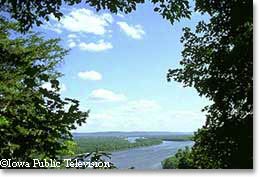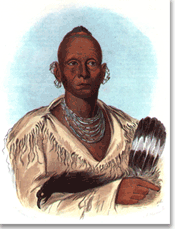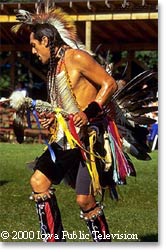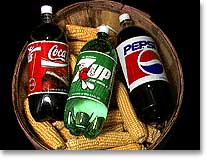Corn as we know it today would not exist if it weren't for the humans that cultivated and developed it. It is a human invention, a plant that does not exist naturally in the wild. It can only survive if planted and protected by humans.

Scientists believe people living in central Mexico developed corn at least 7000 years ago. It was started from a wild grass called teosinte. Teosinte looked very different from our corn today. The kernels were small and were not placed close together like kernels on the husked ear of modern corn. Also known as maize Indians throughout North and South America, eventually depended upon this crop for much of their food.
From Mexico maize spread north into the Southwestern United States and south down the coast to Peru. About 1000 years ago, as Indian people migrated north to the eastern woodlands of present day North America, they brought corn with them.
When Europeans like Columbus made contact with people living in North and South America, corn was a major part of the diet of most native people. When Columbus "discovered" America, he also discovered corn. But up to this time, people living in Europe did not know about corn.
The first Thanksgiving was held in 1621. While sweet potatoes, cranberry sauce and pumpkin pie were not on the menu, Indian corn certainly would have been.

When Columbus reached the Americas, corn was not the only plant Europeans had never seen before. There were many others. And Europeans in turn, introduced several new plants to the native people living in the Americas.
The Sauk and Mesquakie tribes came to live in present-day Iowa during the 1700s. When pioneers began to push toward Iowa in the 1820's and 30s, the Sauk and Mesquakie were living along the Mississippi River at the mouth of the Rock River.
Like other tribes in the region, the Sauk and Mesquakie women planted many acres of corn each spring. They tended the fields surrounding their villages and nurtured gardens of pumpkins, beans and squash.

The most famous Sauk leader was Chief Black Hawk. Near the end of his life, he told his life story to Antoine Le Claire, an Indian interpreter. In part of his story he told how corn first came to be according to Sauk and Mesquakie tradition.
I will here relate the manner in which corn first came. According to tradition, handed down to our people, a beautiful woman was seen to descend from the clouds, and alight upon the earth, by two of our ancestors, who had killed a deer, and were sitting by a fire, roasting a part of it to eat. They were astonished at seeing her, and concluded that she must be hungry, and had smelt the meat-and immediately went to her, taking with them a piece of the roasted venison.They presented it to her, and she eat and told them to return to the spot where she was sitting, at the end of one year, and they would find a reward for their kindness and generosity. She then ascended to the clouds, and disappeared. The two men returned to their village, and explained to the nation what they had seen, done, and heard but were laughed at by their people.When the period arrived, for them to visit this consecrated ground, where they were to find a reward for their attention to the beautiful woman of the clouds, they went with a large party, and found, where her right hand had rested on the ground, corn growing-and where the left hand had rested, beans-and immediately where she had been seated, tobacco. The two first have, ever since, been cultivated by our people, as our principal provisions and the last used for smoking.

The origin of corn is told in the stories of many Indian groups. These tales were preserved as they were told and retold over many generations. Today, many of the stories that only existed through oral tradition have been written down.
Here are a just a few:
The Story of the Corn Husk Doll
The Hermit, or The Gift of Corn
Today there are many kinds of corn. The most common types are flint, dent, sweet and of course popcorn.
Flint corn, also known as Indian corn, has a hard outer shell and kernels with a range of colors from white to red. Today, most flint corn is grown in Central and South America.

Dent corn, often called "field corn" is often used as livestock feed. It is also the main kind of corn used when making industrial products and various foods. It can be either white or yellow.
Sweet corn is often eaten on the cob or it can be canned or frozen. Sweet corn is seldom processed into feed or flour. Sweet corn gets its name because it contains more sugar than other types of corn.
Popcorn, a type of flint corn, has a soft starchy center that is covered by a very hard shell. When popcorn is heated the natural moisture inside the kernel turns to steam that builds up enough pressure for the kernel to explode. When the kernel explodes the white starchy mass that you like to eat forms

Corn was an important part of the diet of many Indian groups. They also used all parts of the corn plant. The husks could be braided and woven to make masks, moccasins, sleeping mats, baskets or cornhusk dolls. Corncobs could be used for fuel, for game darts or for ceremonial use.
There are many uses for corn today as well. Just as Indians depended on corn as a major part of their diet it would be difficult for any American today to live without corn. Fabrics used to make your clothing are strengthened by cornstarch. The chickens that laid the eggs you had for breakfast were fed corn. Many of the soft drinks you enjoy are sweetened with corn syrup.
The textbooks you study from and the books you check out of the library are bound with cornstarch. The ink used to print them contains corn oil. Ethanol is made from corn. The car that carries you to and from school may be powered by fuel containing ethanol. Corn is also used in such products as glue, shoe polish, aspirin, ink, marshmallows, ice cream and cosmetics. New ways of using corn are being developed every day. Our only limitation is our own imagination.

Copyright © 2022 CampSilos | All Rights Reserved
National Standards | Silos & Smokestacks | Credits | Awards
Crafted by IFC Studios, a midwest Branding Agency.